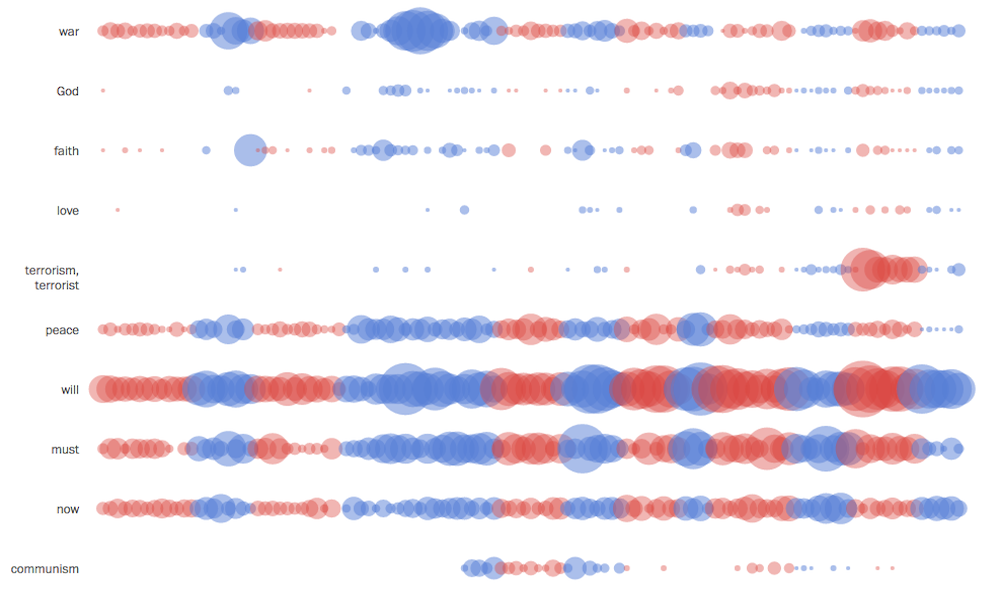In order to sprinkle some star dust into the contents of my book I’ve been doing a few interviews with various professionals from data visualisation and related fields. These people span the spectrum of industries, backgrounds, roles and perspectives. I’ve only scratched the surface with those I have interviewed so far, there’s a long wish list of other people who I haven’t approached yet but will be doing so. I’m aiming to publish a new interview every week through to the publication of my book around April/May 2016, we’ll see how that goes…
I gave each interviewee a selection of questions from which to choose six to respond. The first interview is with Kennedy Elliott, Visual Journalist par excellence at The Washington Post. Thank you, Kennedy!
Q1 | What was your entry point into the field: From what education/career background did you transition into the world of data visualisation/infographics?
A1 | I specialized in Media Studies (media theory and criticism) in undergrad and coded a bit for fun while I was there. After working for a few years editing scientific publications, I decided to go to grad school full time for journalism and be a developer. I thought I’d want to work on infrastructure in newsrooms, but instead I discovered data visualization, and realized I quite liked telling stories in visual ways. After grad school, I moved to New York and worked in industry for a while as a data visualist, but then moved back to journalism, working at the Associated Press, the Guardian US and the Washington Post.
Q2 | What is the single best piece of advice you have been given, have heard or have formed yourself that you would be keen to pass on to someone getting started in a data visualisation/infographics-related discipline?
A2 | Be a great journalist. You might think that learning to code, understanding visual design, user experience or human perception would be the most important part of data visualization, but it’s not. Understanding data is the most important part. There can be so many issues with the information you’re trying to convey, like biased sources, incorrect methodology, incomplete or insufficient data collection, that are necessary to resolve before you begin visualizing. Even if your data is thorough and unbiased, it might not be the correct metric by which to evaluate your thesis. It might not tell the complete story, or even a part of the story accurately. It’s absolutely necessary to investigate the data itself, understand its flaws and report what you can within the proper context before visualizing it.
Q3 | We are all influenced by different principles, formed through our education, experience and/or exposure to others in the field – if you had to pick one guiding principle that is uppermost in your thoughts as you work on a visualisation or infographic, what would it be?
A3 | My main goal is to represent information accurately and in proper context. This spans from data reporting and number crunching to designing human-centered, intuitive and clear visualizations. This is my sole approach, although it is always a work in progress.
Q4 | Given the rich capabilities you and your colleagues possess, the bar is set quite high in terms of the ambitions of what form and what function your visualisation and infographic work can take. Innovation is important, but sometimes you see work out there that evidences people doing things just because they can, rather than because they should. How do you (individually and within the team) maintain clarity of focus and preserve the discipline of avoiding unnecessarily innovation?
A4 | I think having a consistent body of solid work is important here, because I truly feel that experimentation (even for the sake of experimentation) is important, and I wouldn’t discourage it. I think a good rule of thumb is to never allow your design or implementation to obscure the reader understanding the point of your piece. However, I’d be willing to forsake this, at a very minimal level and very infrequently, to allow for the occasional innovation or experiment. It ends up moving us all forward, in some way or another. If you have a reputation for consistent work, then you have earned your right to take risks!
Q5 | What advantages do you think working in a journalistic setting introduces to your visual work?
A5 | I think working in a journalistic setting is the perfect place for visual critique and inspiration. Everyone has varied backgrounds and therefore varied opinions, but we all want the same thing, and that is to tell a great digital story with high journalistic integrity. I think when everyone has the same goal but different experiential wisdom, constructive feedback leads you to discovering new and better things.
Q6 | The judgment of how to elegantly compose and layout a piece is possibly one of the least (publicly) discussed aspects of visualisation and infographic design thinking. Do you have any tips or tactics you can pass on to others about how you approach this?
A6 | The exciting thing about information design is that it is always evolving. It’s a discipline that borrows from sister disciplines – graphic design, product design, interface design. I’m not sure if there are many rules that will still be true in ten years, but I’ll give it a shot. Right now, we try to make things that are intuitive and thusly minimal. We rely on a reader’s previous experience with technology to inform them on how to interact with our work. We use traditional graphic design techniques, like typographical hierarchy, to direct the eye. We use color to communicate meaning when we can, so that design becomes more of a practical endeavor than an ornamental flourish (although we do save room on some projects for ornamental flourishes!). And because technology is always changing, we always have to adapt to how we know (or how we think we know) humans interact with interfaces and process information.

